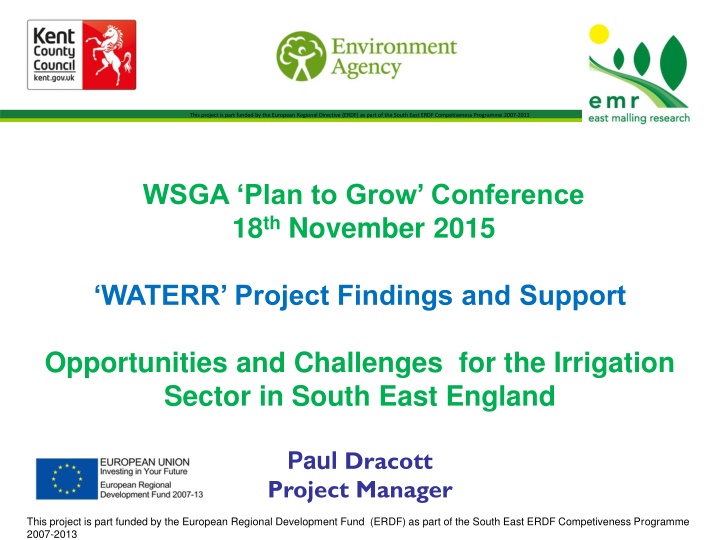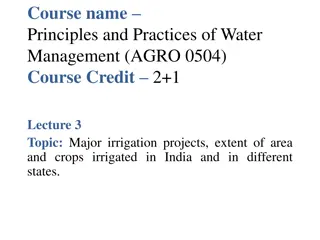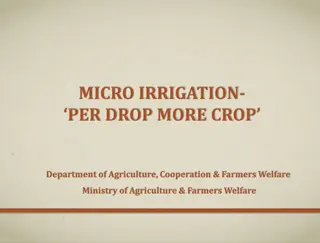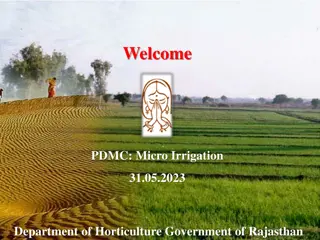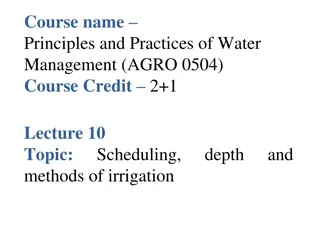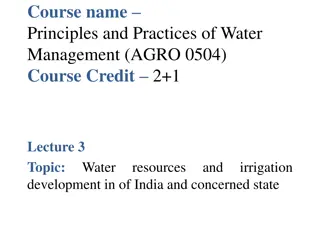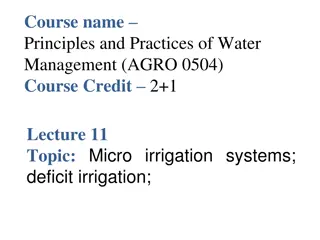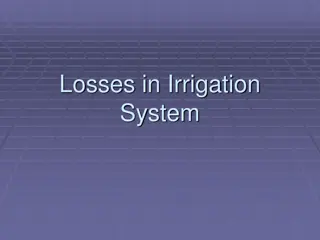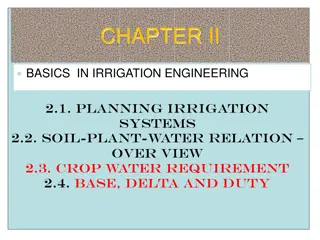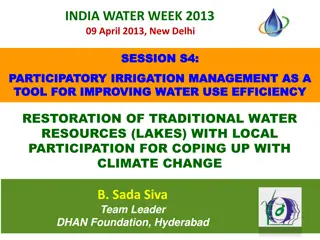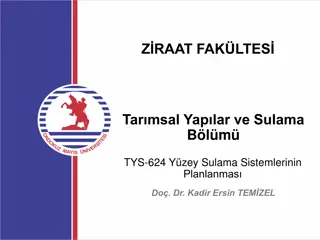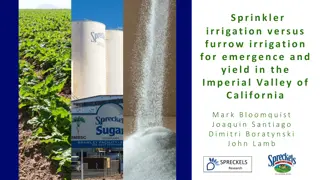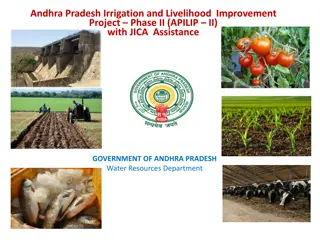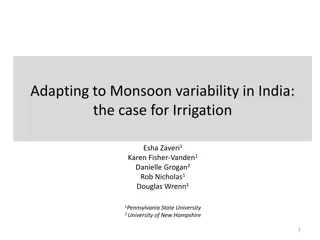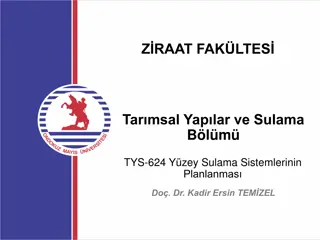WATERR Project Findings and Support Opportunities for Irrigation Sector
This project, part-funded by the European Regional Development Fund, aims to support South East irrigators in improving profitability and competitiveness through enhancing water availability and efficiency. By identifying best practices and leading technologies, the project seeks to increase yields, improve produce quality, and enhance catchment management to reduce environmental impact.
Download Presentation

Please find below an Image/Link to download the presentation.
The content on the website is provided AS IS for your information and personal use only. It may not be sold, licensed, or shared on other websites without obtaining consent from the author.If you encounter any issues during the download, it is possible that the publisher has removed the file from their server.
You are allowed to download the files provided on this website for personal or commercial use, subject to the condition that they are used lawfully. All files are the property of their respective owners.
The content on the website is provided AS IS for your information and personal use only. It may not be sold, licensed, or shared on other websites without obtaining consent from the author.
E N D
Presentation Transcript
This project is part funded by the European Regional Directive (ERDF) as part of the South East ERDF Competiveness Programme 2007-2013 WSGA Plan to Grow Conference 18th November 2015 WATERR Project Findings and Support Opportunities and Challenges for the Irrigation Sector in South East England Paul Dracott Project Manager This project is part funded by the European Regional Development Fund (ERDF) as part of the South East ERDF Competiveness Programme 2007-2013
WATERR Project Background Irrigation is critical for food security: 70% increase in food output needed by 2050 (FAO) Irrigation = 20 % of agricultural land use but 40% of global food production South East catchments / habitats under pressure: Irrigators = largest users of direct water abstractions (rivers / boreholes). Many catchments already Over Abstracted or Over Licensed (EA) EA expect 25% increase in water use by 2020 and most SE catchments Over Abstracted by 2050
WATERR Project Objectives To support South East irrigators to improve their profitability and competitiveness by improving water availability and use efficiency Improve irrigation productivity / returns by identifying and promoting irrigation Best Practice and leading technologies to: Increase yields Improve produce quality / prices Identify opportunities to improve water availability and catchment management Improve the environmental footprint of South East river catchments
WATERR Project Irrigation Business Reviews In depth interviews with 110 growers (30% of South East irrigators / 70% of total irrigation water use) to : Assess current water availability and irrigation use efficiency Impact of irrigation on production / yields, pricing and financial returns Identify Best Practice technologies and techniques Define Grower Support Needs and Priorities Agree WATERR Project Support Programme
WATERR Project Irrigation Business Reviews South East IBR Growers by Sector (Total 5522 Hectares - 27 Crops ) Field Crops 51% (Mainly Spray) Soft Fruit Fruit Crops 37% (Mainly Trickle) Field Vegetables Tree Fruit Potatoes HNS/ Other Salad HNS/ Other 12%
WATERR Project Findings Water Availability Average Water Use by Crop : 2011-2013 Cubic Metres per Hectare 3000 2,495 2500 2000 1,509 1437 1500 1080 886 1000 784 500 197 0 Apples/Pears Lettuce Potatoes Raspberries Field Strawberries Field Raspberries Substrate Strawberries Substrate
WATERR Project Findings Water Availability Impact of Limited Water Availability on Irrigator Businesses in Past 5 Years 1.0%4.8% None Once or twice 3 or 4 times Every year 28.6% 65.7%
WATERR Project Findings Water Availability Adequacy of Abstraction Licence for Current and Future Needs 90 80 70 60 56% 50 Yes No 84% 40 30 20 44% 10 16% 0 a) for your current needs? b) for your future needs?
WATERR Project Findings : Water Availability Summary Water restrictions already impacting a third of all growers Growth of trickle sector increasing pressure on supplies Abstraction Reform planned for 2020 a major concern: If licensed volumes are restricted, or for limited periods only, production will be impacted and future investment decisions very difficult Trickle irrigators particularly concerned about the removal of their licensing exemption Over 30% of growers are planning to increase capacity through new reservoirs and rainwater harvesting. Improving water use efficiency is seen as the best way of addressing water shortages and security of supply.
WATERR Project Findings : Irrigation Performance and Returns Importance of Irrigation to Business Performance 7% 3% 7% Less Important 10% Somewhat Important Important Very Important Crucially Important 73%
WATERR Project Findings : Irrigation Performance and Returns Impact of Irrigation on Financial Returns per Hectare Irrigation Cost Gross Proceeds Financial Benefit of Irrigation: Grower Estimates Average Range Average Average % of Proceeds Potatoes 791 108 - 3,636 8,084 3,904 48% Strawberries : - Field 1,024 209 - 1,860 74,371 31,368 42% - Substrate 2,867 970 - 5,282 106,383 106,383 100% Raspberries: - Field 1,138 554 - 1,800 66,464 51,291 77% - Substrate 2,527 840 - 5,014 74,091 74,091 100%
WATERR Project Findings : Irrigation Performance and Returns Water Use Efficiency - Substrate Strawberries 160 144 140 113 120 100 87 80 Most efficient 60 Least efficient 40 35 31 40 20 0 2011 2012 2013 Productivity : cubic meters per tonne
WATERR Project Findings : Irrigation Performance and Returns Returns and Water Use - Substrate Strawberries 140 133k 120 2360 100 2208 top quartile 80 70k 96 bottom quartile 60 61 40 20 0 '000 Net Proceeds after Irrigation Costs Water Use Per Tonne (M3) Water Use per Hectare (M3)
WATERR Project Findings : Irrigation Performance and Returns Soft Fruit Growers : Best Practice Ranking Use scientific tools to monitor moisture and schedule irrigation 92% Check irrigation water quality 83% Take account of cropping status / weather conditions 83% Regularly check equipment condition / operation 83% Use meters to monitor water usage by crop / field 67% Monitor field water distribution / uniformity 56% Provide irrigation training for staff 50% 0% 20% 40% 60% 80% 100% % Rating Very or Crucially Important
WATERR Project Findings : Irrigation Performance and Returns Summary 2 to 4 fold difference in water use efficiency / productivity Growers of field crops estimate that irrigation accounts for up 75 % of gross proceeds . Strong correlation between irrigation use efficiency and financial returns : Monitoring soil / substrate moisture content to optimise water scheduling / volumes critical to maximising yields Optimisation irrigation also delivers improved produce quality / prices: o shelf life / taste in soft fruit o fruit size / uniformity in tree fruit o tuber size / skin finish in potatoes
WATERR Project Irrigation Business Reviews Irrigator Support Needs / Priorities Ranking - % of Irrigators Rating Very or Crucially Important 1. Learning about planned changes to Abstraction Licensing System (85%) 2. Understanding which technologies/ techniques have the most impact on irrigation water use efficiency and financial returns (70%) 3. Collaborative opportunities to improve catchment management and water demand / supply balance (63%) 4. Understanding how own water use efficiency compares with other abstractors (60%) 5. How to improve own water availability e.g. build reservoirs, rain water harvesting (55%) 6. Visits to sites which demonstrate irrigation Best Practice (54%)
WATERR Project Irrigator Support to Date Water Availability Workshops 5 Workshops involving 128 irrigators / key stakeholders : Review of Abstraction Licensing Reform plans with Leader of the DEFRA Reform Team + NFU / Environment Agency/ River Trusts : options , proposals and potential impact Opportunities to improve catchment management: better Environment Agency / irrigator collaboration Opportunities to improve availability: Water Company untreated water supplies / trading Design Guide for Irrigation Reservoirs
WATERR Project Irrigator Support to Date Irrigation Performance Improvement IBR Follow Ups , Sector / Crop Specific Workshops (x5) , and Best Practice Demonstrations (x4) involving 150 irrigators : Comparative irrigator water use efficiency performance Impact on Financial Returns : Top v Bottom Quartile producers Best Practice technologies/ techniques Latest Research / new technologies : EMR / irrigation suppliers Improvement Potential: 50% of growers targeting a 10 to 25% improvement in productivity Crop Specific Performance Information: Water Use Efficiency / Financial Impact Data Sheets Irrigator Performance and Best Practice Fact Sheets (7 crops)
Irrigator Support Needs Sources of Information Grower Comments Shortage of local advice and training : need crop specific, hands on technical support . Equipment suppliers a key source of information, but equipment often not compatible and integrated / total system support needed. Research organisations need to focus on translating new technologies into commercial use Irrigation Supply Company Research (KCC / ADAS) New technologies / systems can significantly improve irrigation performance but commercialisation requires Greater representation in the South East ( East Anglia focus) Grower engagement: research extension, training and support Collaboration and integration through the supply chain
Improving Irrigator Support: WET Centre Proposal Future Plans UK Centre for Water Efficient Technologies at EMR Objectives Bring together leading irrigation researchers and equipment / services providers at EMR to: Research, develop and commercialise an integrated portfolio of technologies and systems for the tree , soft fruit ,HNS and Salad Crop sectors Deliver a step change in irrigation water use efficiency, productivity and financial returns .
Improving Irrigator Support : WET Centre Proposal WET Centre Strategy Create a Centre of Expertise with the research, development and commercialisation infrastructure and critical mass for suppliers to locate in the South East Engage directly with growers, Producer Organisations and Retailers to ensure technologies developed meet the needs of the horticultural sector / supply chain Develop integrated / compatible products and systems Support commercialisation / raise awareness of the commercial benefits of these new technologies through grower trials, crop specific workshops, demonstrations, training and 1: 1 support .
Improving Irrigator Support : WET Centre Proposal Irrigator Comments It s about getting the right amount of water to where it s required at the right time BUT : There is a lack of knowledge across the industry concerning specific crops. There is a shortage of high level training e.g. CPD type courses We have to draw information from many sources . It would be very helpful if it could all be in one place .
